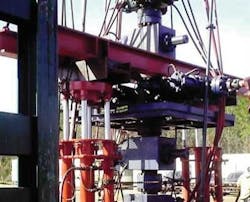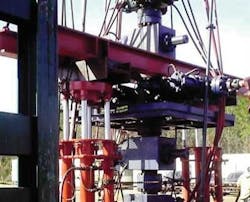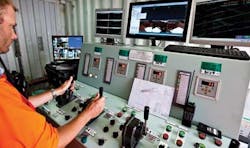Gravity gradiometry shows value in subsalt, transition zones
Phill Houghton
ARKeX
To cross the oil and gas sector technology chasm from niche to widely accepted technology is a long-standing challenge.
In the past, gravity gradiometry (GGI) often was lumped with conventional gravity techniques (which have a limited bandwidth and lower signal to noise ratio compared to GGI) to give the misperception that GGI is unable to measure longer wavelength information, and so is inappropriate for many of today’s exploration challenges such as deepwater and pre-salt.
This misperception has faded as some of the world’s most complex geologies look to GGI and its interpretation abilities as a complimentary or alternative technology to seismic.
ARKeX and other GGI companies play roles to education the client base to see how the increased resolution, bandwidth, and 3D spatial awareness of GGI can reduce uncertainty and risk.
Typical conventional airborne gravity is limited to a resolution of 1 mgal at a bandwidth of ~17.5 MHz. Airborne GGI typically obtains <2.5 Eotvos (a unit of gravity gradient) at 0.1 Hz. This increased resolution is more compatible at the seismic scale and helps support seismic imaging to determine correctly the velocity and density relationship.
Operators also derive benefits from the increased spatial awareness GGI provides. This is achieved by incorporating offline components into the datasets. This is essentially the ability to view geology sideways, and to view the influences on 2D seismic data outside the plane of acquisition, enabling an enhanced interpolation solution between sparse acquisition lines.
When dealing with two seismic lines several miles apart, which can be the case with 2D seismic, it often is difficult to appreciate how two independently interpreted faults may or may not be connected. Lacking information, the interpreter often simply connects the two fault planes.
Full tensor gravity gradiometry with its ability to measure the rate of change of gravity in three dimensions, improves the understanding of the structural fabric.
For example, real-world data shown demonstrates how an interpolation between seismic lines can result in an incorrect interpretation of the fault geometry. From the seismic data lines shown on the accompanying representation, it can be seen that two faults are interpreted on each of the lines. It would be logical to join the corresponding faults between the lines.
However, GGI data shows that not all the information needed to properly extrapolate the fault geometry may not be available from a sparse 2D seismic grid. The GGI data, in conjunction with the seismic data, gives a more complete picture of the fault geometry.
Today there is closer integration between seismic and GGI data, with joint inversion and depth migration projects becoming more prevalent, indicating that GGI is over the technology-acceptance chasm.
Challenge of pre-salt
The development of GGI is being defined and driven by specific challenges facing offshore exploration – two such examples are pre-salt and environmental considerations.
Deeper, more complex geological settings and challenging or environmentally sensitive operating conditions all pose issues for operators.
Seismic pre-salt imaging remains a challenge. While this has been partly addressed with expensive and elaborate acquisition strategies and technological advances post-acquisition – such as improved seismic data processing and increased speed to the 3D migration – such processes still depend on illumination of the target in order to be modelled by the migration algorithm. Without this successful illumination, portions of the seismic volume always have poor resolution – even with the most accurate velocity model.
Even if a geology is best explored with high-resolution 3D acquisition surveys, such surveys are not always possible due to access issues, costs, the environment, and the size of the potential survey area. In such circumstances, the operator requires as many data sets as possible to develop accurate velocity models with quantified uncertainty and better de-risk pre-salt targets.
GGI’s ability to accurately map the density contrast between salt and the surrounding rock and its ability to add 3D velocity constraint to an otherwise interpolated field, density and velocity models can be enhanced and a clearer picture of the pre-salt basins can be generated.
Keeping environmental control
The third key to growing acceptance of GGI is another offshore challenge – the need for increased environmental control and a light “footprint.”
With offshore petroleum reservoirs often found in environmentally fragile areas, GGI and its passive technology (with instrumentation either mounted in an airplane or marine vessel) provides increased flexibility to operators.
More exploration is taking place in transition zones between onshore and offshore areas – the swamps of the Gulf Coast, for example, where there are significant gaps in data coverage. In such areas, it is difficult for seismic vessels with long streamers to make turns without impacting on the environment.
The same goes for other environmentally fragile offshore exploration areas, such as the sturgeon breeding grounds close to the Caspian Sea and whale migration offshore Norway. In such regions gravity gradiometry is an effective but non-invasive offshore exploration technology.
And the lack of any environmental footprint also provides obvious cost benefits for the offshore operator, with large areas cost-efficiently surveyed and pre-screened prior to additional seismic spend or in advance of leasing decisions.
Offshore exploration in Gabon
One example of where GGI is being combined with seismic is in offshore Gabon. ARKeX recently completed a GGI survey on behalf of CGGVeritas over 9,000 sq km (3,745 sq mi) of the Zone Sud area off the coast of Gabon.
The survey was part of a comprehensive program undertaken by CGGVeritas in partnership with the Ministere des Mines du Petrole et des Hydrocarbures with technical support from the Direction Generale des Hydrocarbures to improve understanding of untapped potential in the pre-salt province of Gabon to coincide with the recently announced 10th Gabonese Licensing Round. These deepwater blocks are virtually unexplored due to the large, complex salt sheet which hides the prospective geology.
Using ARKeX’s BlueQube gravity gradiometry solution, data has been acquired to better constrain the extent of individual salt bodies for an accurate earth model and PSDM, to improve geologic modelling, and to identify areas where future 3D seismic acquisition should be done.
Gulf of Mexico
GGI has been applied effectively in a transition zone of the Gulf of Mexico along the Louisiana coast. The survey, a collaboration between ARKeX and ION, was designed to interpret the geologic fabric along the coastline, as well as to assist in building seismic velocity models.
In transition zones, acquiring new 3D and 2D seismic can be expensive and time consuming. The GGI survey provided a cost-effective solution to the geological challenges of the survey area. The data will be incorporated into the GulfSPAN project, developed by ION’s GX Technology (GXT) group to give geoscientists a basin-level tool for the GoM petroleum system.
One key benefit of the survey is its ability to map faults between the existing 2D seismic data. The Miocene and Sub-Miocene growth fault systems were well mapped on ION’s GulfSPAN data but were unconstrained between seismic lines. The GGI data provided an independent measurement of the spatial location and geometry of faults and salt features, resulting in increased confidence in velocity model building and subsequent depth imaging and regional interpretation.
GGI‘s increased bandwidth and resolution helped extrapolate and infer the 2D seismic data into 3D space, effectively acting as a 3D geologic interpolator. The result was an improved velocity model, increased support with seismic reprocessing, and improved 3D interpretation.
GGI grows as exploration tool
The last few years show a growing acceptance of gravity gradiometry imaging (GGI) in exploration and as a technology complementary to seismic.
First commercialized in the early 1990s, GGI, which maps minute density variations in the underlying rocks by measuring the gradient of the earth’s gravity field, only now is viewed as a key part of the exploration toolkit.
Today, some of the world’s leading international and national operators are issuing tenders for GGI projects, with a number of high profile supporters including David Bamford, former head of Exploration at BP, who was quoted on his blog as saying: “If I had to choose one potentially ‘transformational’ technology of today, unusually for me I would look away from the seismic world to gravity gradiometry.” (Source: Finding Petroleum, August 2009).
The issuance of tenders is one measure of confidence and growing acceptance of the technique and, since 2007, the author has seen sales increase from nothing in 2007 to $19 million in 2009. The number of tenders for 2010 is already at 2009 levels. This increase covers both onshore and offshore activity.
Why is GGI finally being taken seriously?
There are three key reasons.
- 1. It has finally come out of the technology chasm and is seen as a real benefit by today’s operators.
- 2. It addresses some of today’s key offshore exploration challenges – pre-salt for example.
- 3. It provides increased environmental control in offshore exploration, again something that operators demand.


